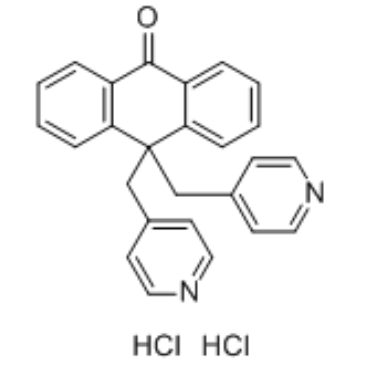| Cas No.: | 122955-13-9 |
| Chemical Name: | 10,10-bis(4-Pyridinylmethyl)-9(10H)-anthracenone dihydrochloride |
| Synonyms: | XE-991;XE991 |
| SMILES: | Cl.Cl.N1=CC=C(C=C1)CC2(CC3=CC=NC=C3)C4C(=CC=CC=4)C(=O)C5C2=CC=CC=5 |
| Formula: | C26H20N2O.2HCl |
| M.Wt: | 449.37 |
| Purity: | >98% |
| Sotrage: | 2 years -20°C Powder, 2 weeks 4°C in DMSO, 6 months -80°C in DMSO |
| Publication: | [1]. Wang HS, et al. KCNQ2 and KCNQ3 potassium channel subunits: molecular correlates of the M-channel. Science. 1998 Dec 4;282(5395):1890-3. [2]. Zaczek R, et al. Two new potent neurotransmitter release enhancers, 10,10-bis(4-pyridinylmethyl)-9(10H)-anthracenone and 10,10-bis(2-fluoro-4-pyridinylmethyl)-9(10H)-anthracenone: comparison to linopirdine. J Pharmacol Exp Ther. 1998 May;285(2):724-30. |
| Description: | XE 991 dihydrochloride, a Kv7 (KCNQ) channels blocker, potently inhibits Kv7.1 (KCNQ1), Kv7.2 (KCNQ2), Kv7.2 + Kv7.3 (KCNQ3) channel, and M-current with IC50s of 0.75 µM, 0.71 µM, 0.6 μM, and 0.98 µM, respectively[1]. |
| Target: | IC50: 0.75 µM ( Kv7.1 channel), 0.71 µM (Kv7.2 channel), 0.6 µM (Kv7.2 + Kv7.3 channel), 0.98 μM (M-current)[1] |
| In Vitro: | XE 991 dihydrochloride possesses an EC50 of 490 nM for enhancement of [3H]ACh release from rat brain slices, and shows good in vivo potency and duration of action[2]. |
| References: | [1]. Wang HS, et al. KCNQ2 and KCNQ3 potassium channel subunits: molecular correlates of the M-channel. Science. 1998 Dec 4;282(5395):1890-3. [2]. Zaczek R, et al. Two new potent neurotransmitter release enhancers, 10,10-bis(4-pyridinylmethyl)-9(10H)-anthracenone and 10,10-bis(2-fluoro-4-pyridinylmethyl)-9(10H)-anthracenone: comparison to linopirdine. J Pharmacol Exp Ther. 1998 May;285(2):724-30 |

 To enhance service speed and avoid tariff delays, we've opened a US warehouse. All US orders ship directly from our US facility.
To enhance service speed and avoid tariff delays, we've opened a US warehouse. All US orders ship directly from our US facility.




















